With the rapid development of my country’s socialist market economy, the system of joint and several liability has been established in my country’s civil and commercial law and is playing an increasingly important role. There are also problems such as scattered regulations and contradictory laws and regulations at the level. Since there is no unified application principle established in judicial practice, the litigation burden caused by the recovery lawsuit also wastes a lot of trial resources. Dimensional key features distinguish confusing charges. Use regular expression technology to extract key content such as fact descriptions, defendants’ charges, relevant laws and regulations in legal documents and create JSON format documents; use stammer word segmentation and stop word list to remove stop words; use Word2Vec algorithm to represent text into vector form , establish a judicial judgment prediction model and an optimization model, and through experimental comparison, it is concluded that the performance of the model after adding focal loss is improved by 1.82%, 0.45%, 1.62%, and 1.62% compared with the cross entropy loss, and the final accuracy of the optimized model is 84.78%. , the precision rate is 87%, the recall rate is 85%, and the F1 value is 85%. The system is expected to assist judicial workers in classifying crimes with joint liability and reduce the burden of judicial workers reading many legal documents to classify crimes.
In civil trials, people’s courts often make judgments of “assume joint and several liability for repayment” or “assume joint and several liability for compensation” when hearing cases involving debts of the majority [1-3]. However, due to the unclear concept of joint and several liability, the characteristics of joint and several liability, the causes and causes of joint and several liability, and the effect of joint and several liability, the phenomenon of joint and several liability as a civil liability bearing method has been abused and omitted in judicial practice. Either aggravate the responsibility of the responsible person or damage the rights of the right holder. The reason for this chaotic phenomenon is of course due to the immaturity of legislative technology. For example, the legislation on joint and several liability is scattered and not systematic, and there is no uniform applicable standard. At the same time, the lag of academic research is also an important reason [4,5].
As a branch of civil liability, joint and several liability in civil and commercial law continues to develop with the development of my country’s economy and politics, and the problems are becoming more and more obvious. First of all, joint and several liability is an important weapon to protect the rights holders. By tying the responsible persons together tightly, they cannot cause further infringements on the rights holders through other means. The joint and several ropes form an important guarantee. The more thorough protection of civil rights has advantages unmatched by other rights systems [6,7]. The development of the responsibility system has also gone through a long process, from the feudal period, and the combination of social identity has its social foundation. After the fall of feudal society and the rise of capitalism, the form of individual responsibility dominates, and joint responsibility loses its own superiority, showing a trend of decline [8]. The formulation of the General Principles of Civil Law was limited by the level of economic and political development at that time, and the resulting impact was that the provisions on joint and several liability were scattered and unsystematic. Do systematic and systematic analysis. The lag in theory and the rapid development of joint and several liability form a sharp contrast. After experiencing the pains of growth, joint and several liability has fully demonstrated its superiority and is active in various fields of society.
In the field of legal case retrieval, deep learning technology has also been widely used, but there are still some obvious bottlenecks. The participation of experts, and huge time and effort, lead to the high cost and scarcity of labeled data for legal case retrieval. However, in-depth retrieval models generally to achieve ideal results [9]. To ensure the openness of the judicial process and the fairness of judicial results, artificial intelligence has gradually penetrated into the judicial industry. Judicial intelligence is mainly reflected in the use of machines to realize judicial punishment [10,11]. Deep learning technology is that the computer completes the processing of various data through the instructions of the algorithm and learns in the process of processing the data. When new data is input, the algorithm can complete functions such as data prediction and induction. In judicial judgment, deep learning technology is used to simulate the behavior of judicial personnel to read legal documents, to realize the functions of crime prediction and law recommendation.
Deep learning technology summarizes and improves algorithms based on machine learning technology. Deep learning technology is usually applied to various fields of artificial intelligence. It does not perform deduction in various fields but summarizes and summarizes the data processed in various fields [12]. Ensure the public’s trust in the openness of the judicial process, but also refer to the trial results. Trial result. Therefore, applying deep learning technology to the judicial field can further accelerate the process of comprehensively governing the country by law. Therefore, aiming at the bottleneck existing in the legal case retrieval system of joint liability in civil and commercial law, this paper proposes a deep legal case retrieval model based on the prompt paradigm on the one hand, which alleviates the deep model’s dependence on large-scale labeled data; on the other hand, it designs a method to construct legal cases Common sense knowledge map, and related application algorithms and models are designed, so that the legal case retrieval system can use rich legal expertise in the retrieval process, improve the retrieval system’s ability to model the input query text, and improve the law enforcement effect.
From a domestic perspective, due to the influence of my country’s economic, political and historical development, and the influence of the current political and economic environment during the drafting of the “General Principles of Civil Law”, there are still certain problems in the current joint liability system. The effect of joint and several liability is unsatisfactory. There is a sharp contrast and strong contrast between the importance of theoretical circles and the unsystematic nature of actual research results. [13] believes that joint and several liability is a kind of joint responsibility, and the responsible persons must be two or more subjects who can independently bear civil liability. This is one of the fundamental characteristics of joint and several liability that is different from ordinary liability. Ordinary responsibility is mostly sole responsibility, that is, only one responsible person is responsible to the right holder, which is also the most normal responsibility. [14] believes that joint and several liability is different from individual liability. It requires multiple responsible persons to be jointly responsible for the right holder. This is a form of responsibility created by the law in response to the inadequate protection of individual liability for the right holder, and the number of responsible persons increases. It means that the liability property increases and the possibility of realizing the interests of the right holder increases. Of course, the co-responsible persons here must also have the capacity for civil liability, that is, be able to independently assume civil liability. [15] believes that the capacity for civil liability is usually based on the basis and premise of the capacity for civil conduct but does not rule out exceptions. According to the relevant provisions of our country’s laws, persons without capacity for civil conduct cannot conduct civil acts, except for acts of pure gain such as accepting rewards, gifts, and remuneration. In addition, they should be represented by their legal representative or with the consent of the legal representative. Therefore, persons without civil capacity and limited civil capacity cannot bear civil liability independently under normal circumstances, so they cannot be regarded as jointly and severally liable. the subject.
To sum up, the problems and effective countermeasures in the joint liability of civil and commercial law based on deep learning assessment have strong practical significance.
Figure 1 is the data processing flow of deep learning to be used for joint liability judgment.

Judicial decision-making not only needs to bypass the neural network to classify legal documents, but also needs frequent neural network algorithms to deal with the text background. Therefore, the algorithm to improve the prediction of judicial decision-making mode is also the same. Due to poor memory, the best model of this document is the combination of neural network and automatic attention conversion. Network transmission is the best choice based on repetitive neural networks and an alternative to repetitive neural networks. The essence of network transmission is the same as that of repetitive neural network. It is the first research that combines repetitive neural network algorithm and neural network protocol [].
Figure 2 is the structure diagram of the cyclic convolutional neural network. The max pooling layer in the neural network extracts key features.
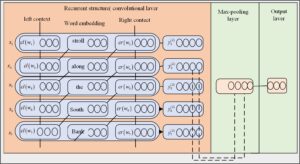
With one hidden layer, as shown in Figure 3, because the error can be directly fed back to the output layer node, the left parameter matrix directly connected to the output layer node can directly optimize the parameters through the error, while with The right parameter matrix directly connected to the hidden layer nodes cannot be directly optimized because the direct feedback of the error cannot be obtained. The backpropagation algorithm can make the error feedback be transmitted to the hidden layer nodes, thereby generating indirect errors, so it is related to the hidden layer. The left weight matrix directly connected to the layer nodes can be updated by indirect error. After several rounds of iteration, the error will be reduced to a minimum. By the same analogy, the reverse of the multi-layer neural network can be obtained [17].
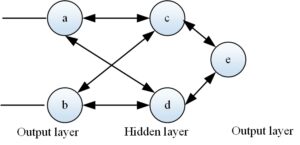
The model evaluation index can easily and concisely count the classification results of the model and the training situation of the model. First, the confusion matrix in the model evaluation index is introduced. The confusion matrix contains four parameters, as shown in Table 1, which are true examples and true counterexamples.
| Positive prediction example | Forecast counterexample | Total | |
| Actual positive example | real case | false counter example | false counter example |
| Actual counterexample | false positive example | true counterexample | true counterexample |
| Total | TP+FP | FN+TN | TP+FN+FP+TN |
In text classification, the correctness of the classification includes the correctness of the sample and the correctness of the classification category [18]. For example, the crime of theft in the sample is divided into the sample of theft, which is the correctness of the sample. When the model uses the sample to predict the crime, the crime of theft is predicted, which is the correctness of the classification, and only if the two correct nesses are satisfied at the same time can the classification be correct. Its formula is shown in Eq (1) and (2):
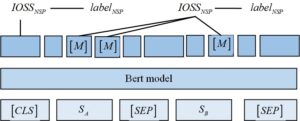
The formula for calculating the predicted value of MLM and NSP tasks is as Eqs. (3) and (4):
The loss function of this stage is consistent with the form of the first stage, which is also the biggest feature of training based on the cue paradigm. The training form of this stage is shown in Figure 5.
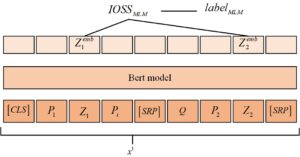
After the above multi-stage distillation, the obtained Tiny-BERT model is directly used in the feature fusion training stage for training, and finally the Tiny-BERT-based retrieval model is close to the BERT-based retrieval model, but the inference speed is greatly improved [8].
Through the above introduction to the single-layer and multi-layer structure of the end-to-end memory network model structure, it can be known that the case description and the external memory storage part are under the terms of the supporting legal provisions, and the data is calculated and processed in the network structure.
The specific configuration of the experimental environment used in the end-to-end memory network’s crime prediction is shown in Table 2.
| Experimental | Environment configuration |
|---|---|
| Host | Dawning workstation |
| Operating system | ubuntul6 04 LTS |
| System type | Position64 |
| Disk size | IT |
The final hyperparameters are shown in Table 3.
| Parameter | Batch size | Embed ding size | Learning rate | Dropout |
|---|---|---|---|---|
| Parameter value | 32 | 22 | 0.002 | 0.06 |
Table 4 comparison results between the proposed model and other models.
Table 4 show that the end-to-end memory network is very effective in the prediction of joint liability, the method obtains 85.1% of the F1 evaluation value, while the previous best model only obtains 83.4% of the F1 evaluation value.
Therefore, we added various sizes of revolution cores around it to compare and analyze the optimal sizes of multiple revolution cores of the optimization model. The added revolution core sizes are [3,4,5], [4,5,6], [2,3,4,5], [2,3,4,5], [2,3,4,5], [2,3,4,5,6], as shown in Figure 6.
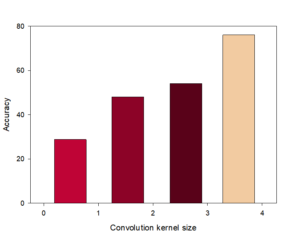
Make the model learn the labels that are difficult to train, thereby increasing the performance of the model and improving the efficiency of model training. After sorting out the data in the table, a histogram of the evaluation values of the model is obtained, as shown in Figure 7.
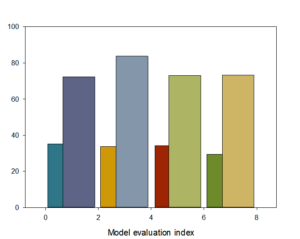
The GRU network is an improvement of the recurrent neural network. The shortcomings of the short-term memory of the recurrent neural network have been improved, so the GRU network has the function of extracting long dependent information and can capture the context and word order of the text data. Higher weights, in turn, make the optimized model perform better.
This paper takes the prediction of the crime of joint and several liability in the judicial judgment and punishment as the research goal and applies the deep learning technology in the field of artificial intelligence to the judicial judgment and punishment and realizes the judicial intelligence. With the continuous maturity of technologies such as deep learning, sufficient technical support is provided for judicial judgment and punishment of joint liability in civil and commercial law. Therefore, the research on judicial judgment and punishment of joint liability in civil and commercial law based on deep learning is expected to assist judicial sentencing. The application of the judicial penalty model can not only ease the burden of judicial workers to read many legal documents, but also make judicial penalty more fair, just and open.
Author declares no conflict of interests.
1970-2025 CP (Manitoba, Canada) unless otherwise stated.